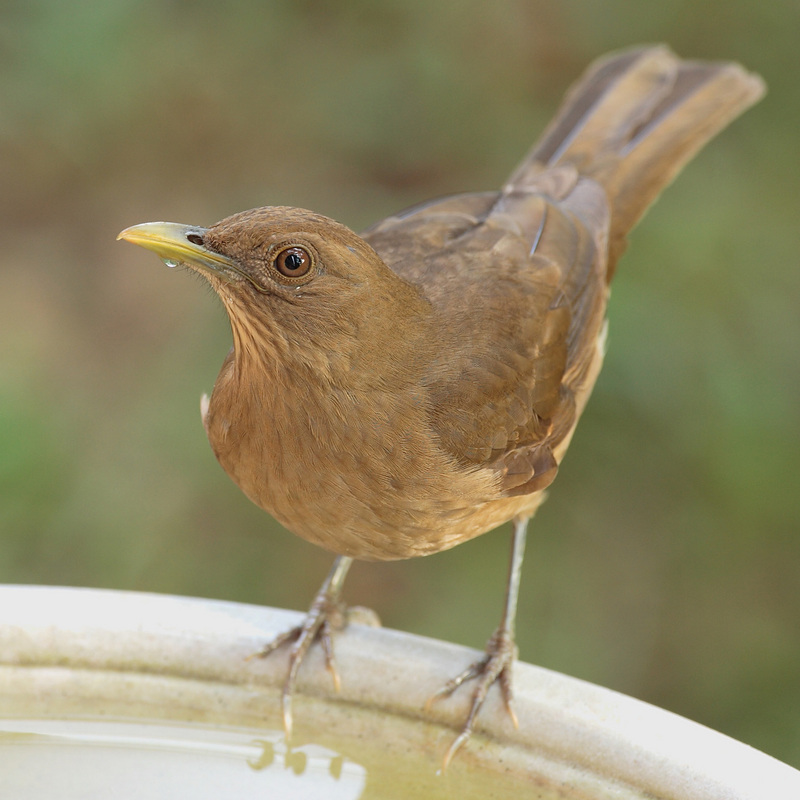| New Photos | Animal News | Animal Sounds | Animal Movies | Upload Photo | Copyright | Korean |
|---|
| Funny Animal Photos | Monsters in Animalia | Wiki Articles Fun Facts about Animals | Links | Home | Mobile A.P.A. |
|---|
| Image Info | Original File Name: Turdus-grayi-001 Clay-colored Robin or Thrush.jpg Resolution: 1536x1536 File Size: 421803 Bytes Date: 2005:12:07 21:40:25 Camera: Canon EOS-1D Mark II (Canon) F number: f/5.7 Exposure: 1/30 sec Focal Length: 500/1 Upload Time: 2008:02:02 00:19:45 | |
| Author | Name (E-mail): Unknown | |
| Subject | Clay-colored Robin (Turdus grayi) - Wiki | |
 |
| Email : E-Card | Poster | Web Master Delete Edit Info Admin |
| Description | Clay-colored Robin (Turdus grayi) - Wiki
Clay-colored Robin
The Clay-colored Robin or Clay-colored Thrush (Turdus grayi) is a common Central American bird of the thrush family (Turdidae|). It is the national bird of Costa Rica, where it is well known as the yigüirro. It ranges from northeastern Mexico to northern Colombia; west and north of the Isthmus of Tehuantepec it is limited to the Atlantic slope, except for a population around Oaxaca City that probably originates from escaped cagebirds. It occurs rarely in south Texas, mostly in winter, and has bred there. Its habitat is open areas with trees or hedges and forest edges. Description In general appearance and habits it resembles other Turdus thrushes such as the American Robin. It is about the same length or slightly smaller: 23–27 cm (9–10.5 in), and weighs 74–76 g (2.6 oz.) on average. The plumage is brownish, somewhat lighter below than above, lightest on the flanks. Birds from humid regions are darker than those from dry regions. The throat is faintly streaked. Immature birds have faint mottling on the back and underparts. The bill is greenish-yellow with a dark base, the legs are pinkish or flesh-colored, and the irises are reddish – all useful identification points. The song, rather low-pitched and with a slow steady tempo, consists of many slurred musical phrases which are often repeated irregularly. The tock flight call is like the American Robin's but harsher. Ecology In much of its range it is familiar in yards and gardens, similar to some other thrushes such as the American Robin, the Eurasian Blackbird, and the Song Thrush. In 1977 the Costa Ricans chose the yigüirro (over many much more colorful birds that inhabit the country) as a tribute to its strong and melodious song that always comes during the start of the rainy season. In addition, unlike many of the forest songsters of Costa Rica, the present bird has been familiar to the general population since the country's early history, thanks to the species' tendency to live near houses and settlements. The Clay-colored Robin usually forages for fruit or invertebrates on the ground or near it, singly or in pairs, but flocks may feed high in fruiting trees. It will follow army ants to feed on small prey disturbed by the ant columns. It builds a heavy cup nest of grass, moss, and mud on a firm support above the ground, which may include human constructions such as windowsills. It lays 2 to 4 pale blue eggs with red-brown and gray markings between March and July and may double-brood. It is aggressive in defense of its nest, but is not otherwise particularly territorial. http://en.wikipedia.org/wiki/Clay-colored_Robin
| |||
| Copyright Info | AnimmalPicturesArchive.com does not have the copyright for this image. This photograph or artwork is copyright by the photographer or the original artist. If you are to use this photograph, please contact the copyright owner or the poster. |
|
|
|
| |||||||
| CopyLeft © since 1995, Animal Pictures Archive. All rights may be reserved. | ||||||||
Stats